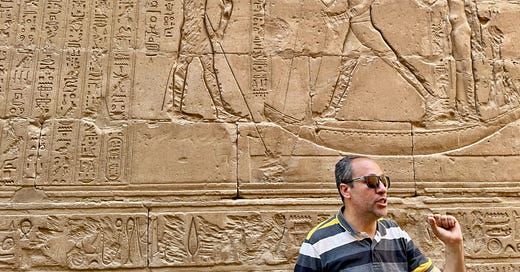Today is Easter Sunday. I found myself seated on a slowly gliding vessel on the Nile, listening to Prof. Galal Kayed in history deliver a sweeping, impassioned lecture on the rise and resilience of Egyptian civilization. We were just hours away from docking in Luxor, the ancient city of Thebes — once the beating heart of a civilization that dared to design for eternity.
Something about today’s timing felt poetic.
As Professor Kayed traced the arc of Egypt’s story, from the myth of Atum rising from the eternal waters to the cosmic choreography of Abu Simbel’s solar alignment — I felt an unexpected clarity.
It was as if the three essays I had recently written suddenly revealed a common thread:
1. Writing for Mortality: A Dinner Among Friends wrestled with how we prepare, mentally and spiritually, for the limits of our time.
2. Build for Eternity: Reflections from Day 2 stood at the foot of the Great Pyramid, asking what it means to create something that defies decay.
3. At the Gate of Glory: Who Owns the Suez Canal? examined ownership, legacy, and how geography and time collide to test human ambition.
Today, those ideas converged.
Not in theory, but on the water.
Egyptians didn’t just build temples and tombs. They engineered meaning.
They imagined resurrection long before it was Christian. They assigned gods to grief, healing, betrayal, and revenge — not as abstractions, but as mechanisms to understand the human condition.
- Osiris, betrayed and scattered, was reassembled not just in body but in belief.
- Isis, a goddess and widow, became a symbol of endurance, stitching together the broken.
- Horus, their son, emerged as the righteous avenger, a cycle complete, yet always repeating.
On Easter Sunday, how can one not feel the resonance?
Professor Kayed’s voice, echoing through the cruise ship lounge, brushing the air with stories that float between myth and truth, offered more than facts. He invited us to interpret: to see beyond the stones, beyond the names, and ask why did they endure?
Like the Rosetta Stone, his words translated more than language, they translated mindsets.
What struck me most wasn’t just Egypt’s engineering of structures, but their engineering of belief systems. They invented tools not just for medicine and astronomy, but for emotional architecture — how to grieve, to hope, to explain the unexplainable.
If Easter is about resurrection, Egypt is about how to resurrect;
Piece by piece, belief by belief.
As I watched the Nile ripple past, I thought of our own fragmented lives. Perhaps we are all a little like Osiris, scattered across time and experience, waiting to be reassembled by memory, healing, and myth-making.
I realize now that koffeemocha, in its own quiet way, is also a practice of resurrection. A stitching together of reflections. An invitation to design not for grandeur, but for meaning.
As I prepare to write the next chapter of my journey, from Luxor’s tombs to Cairo’s chaos, I carry this renewed sense of purpose:
To keep writing.
To keep listening.
To keep reassembling.
Because what we leave behind is not just what we build, but what we interpret, reflect, and pass on.
Happy Easter.
Kefei|Koffee
From the waters of the Nile, and The East Bank of Luxor




